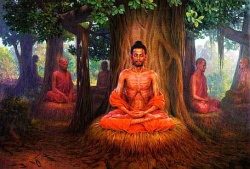Vassa: By Barbara O'Brien
By Barbara O'Brien
Vassa is a three-month annual retreat observed by Theravada monks and nuns. It begins on the day after the full moon day of the eighth lunar month of the common Buddhist calendar, which usually falls in July. The retreat ends on the 15th day of the waxing moon of the eleventh lunar month, usually in October.
During Vassa, monks and nuns remain inside monasteries and temple grounds, devoting their time to intensive meditation and study. Laypeople support the monastic sangha by bringing food, candles and other offerings to temples. Laypeople also often observe Vassa by giving up something, such as smoking or eating meat. For this reason, westerners sometimes call Vassa the "Buddhist Lent."
The tradition of Vassa began during the life of the Buddha. Most of the time, the first Buddhist monks who followed the Buddha did not stay in one place, but walked from village to village to teach. They begged for their food and often slept outdoors, sheltered only by trees.
But during India’s summer rainy season living as homeless ascetics became difficult. So, groups of monks would find a place to stay together until the rain stopped, forming a temporary community. Wealthy laypeople sometimes sheltered monks on their estates. Eventually a few of these patrons built permanent houses for monks, which amounted to an early form of monastery.
